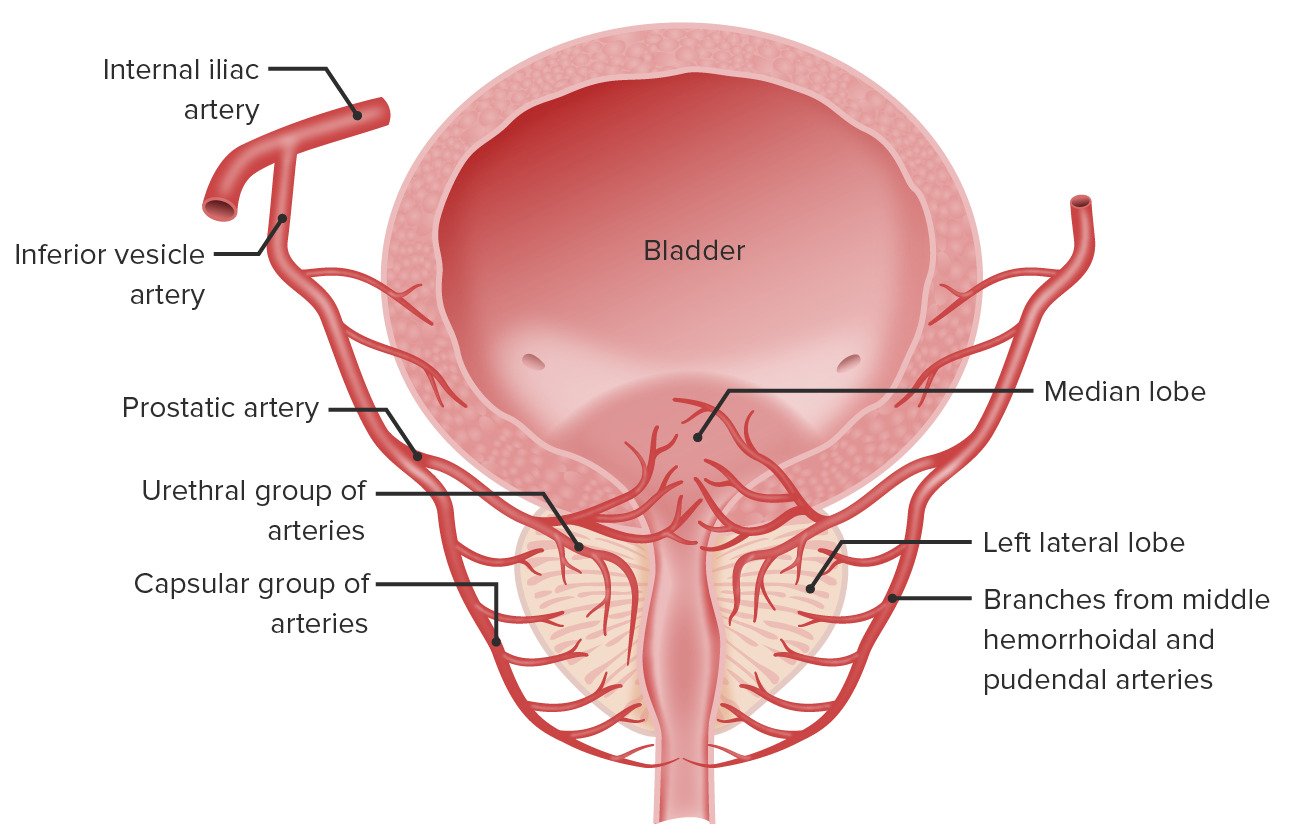Playlist
Show Playlist
Hide Playlist
Anatomy of the Prostate
-
Slides Anatomy of the Prostate.pdf
-
Download Lecture Overview
00:01 Now, let's have a look at how this urethra is receiving these structures as it's situated within the prostate. 00:08 So, first of all, let's have a look at the prostate. 00:10 So we can see an anterior view of the prostate here. 00:13 It's about the size of a golf ball. 00:15 As you remember, it's immediately inferior to the bladder. 00:19 We've got the base of the prostate here, which is in close opposition to the bladder, specifically the internal urethral orifice or the neck of the bladder. 00:29 And then it tapers down into an apex as the urethra then passes through the prostate. 00:34 And it's situated on the muscles of the pelvic floor. 00:37 We'll come back to those later on. 00:40 If we can now see that in a lateral view, we can see the bladder is superior to the prostate. 00:46 We have inferiorly and laterally. 00:48 We have the muscles of the pelvic floor. 00:50 And then anteriorly we've got the pubic symphysis and the rectum and its associated fascia positioned posteriorly. 00:58 So, now let's have a look at the urethra as it passes through the prostate, which we can divide into a number of different zones. 01:05 So, running around the urethra, completely enclosing it as it passes through the prostate is the transitional zone. 01:12 And this is the area that can be burnt away with an electric current if you were to have hypotrophy of the prostate. 01:18 So transurethral resection of the prostate inserts an electric current via little electric wire that passes through the urethra and then can scrape through this transitional zone. 01:30 And that helps to increase the size of the urethra to allow for effective urine production. 01:36 With hypertrophy of the prostate due to overproduction of testosterone via the testes can cause that hypertrophy of the prostate. 01:44 There's then a number of other surrounding zones around the transitional zone within the prostate. 01:49 So we have a central, a peripheral, and a nonglandular anterior region. 01:53 And these form the substance of the prostate that encloses the urethra. 01:58 If we then have a look at the prostate in section so here in coronal section, we have the prostate section. 02:04 We see the urethra passing through the substance of the prostate. 02:08 But let's have a look at the region towards the top of the prostate known as the urethral crest. 02:13 Because there's some important openings here. 02:16 We have the openings for the ejaculatory ducts, which we can see either side of the midline and these run into the prostatic sinus which allows that fluid to aggregate within the urethra as it passes through the prostate. 02:30 We also have the prostatic utricle which doesn't have a function in the male. 02:34 It's just a blind ended tube. 02:36 But in the female it would be the vagina and the uterus. 02:40 And here we have in the prostatic sinus we have the openings of the prostatic ducts. 02:45 Remember the prostate is important in producing that alkaline milky substance that forms the semen and that helps to protect the sperm as they pass through the urethra. 02:56 The seminal vesicles are producing that high fructose aspect of that fluid that passes down into the urethra as well. 03:02 Remember the bulbourethral glands form the pre-ejaculate, and that precedes the passing of the semen, helping to again neutralize the acidic environment of the urethra, but also the acidic environment of the vagina. 03:17 If we then move into a closer section, mount the inferior aspect of the prostate here we can now see those two bulbourethral glands. 03:25 They're not positioned within the prostate, they're positioned outside of the prostate. 03:29 We have two of them either side of the midline, and here we have them passing into the urethra. 03:34 Again, that's contributing to that pre-ejaculate, that precedes the flow of semen.
About the Lecture
The lecture Anatomy of the Prostate by James Pickering, PhD is from the course Anatomy of the Male Reproductive System.
Included Quiz Questions
What is directly inferior to the prostate?
- Muscles of the pelvic floor
- Bladder
- Pubic symphysis
- Rectum
- Peritoneum
What zone of the prostate is removed during transurethral resection of the prostate?
- Transitional zone
- Peripheral zone
- Medial zone
- Anterior zone
- Central zone
Where are the bulbourethral glands in relation to the prostate?
- Inferior
- Superior
- Anterior
- Lateral
- Posterior
Customer reviews
5,0 of 5 stars
| 5 Stars |
|
5 |
| 4 Stars |
|
0 |
| 3 Stars |
|
0 |
| 2 Stars |
|
0 |
| 1 Star |
|
0 |




